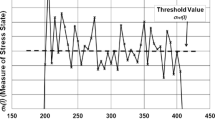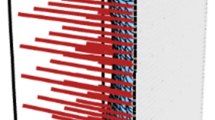Abstract
External remodelling is significant in the bone healing process, and it is essential to predict the bone external shape in the design of artificial bone grafts. This paper demonstrates the effectiveness of the evolutionary structural optimisation (ESO) method for the simulation of bone morphology. A two-dimensional ESO strategy is developed which is capable of finding the modified bone topology beginning with any geometry under any loading conditions. The morphology of bone structure is described by the quantitative bone adaptation theory, which is integrated with the finite element method. The evolutionary topology optimisation process is introduced to find the bone shape. A rectangle, which occupies a larger space than the external shape of the bone structure, is specified as a design domain; the evolutionary process iteratively eliminates and redistributes material throughout the domain to obtain an optimum arrangement of bone materials. The technique has been tested on a wide range of examples. In this paper, the formation of trabecular bone architecture around an implant is studied; as another example, the growth of the coronal section of a vertebral body is predicted. The examples support the assertion that the external shape of bone structure can be successfully predicted by the proposed ESO procedure.
Similar content being viewed by others
References
Beaupre GS, Orr TE, Carter DR (1990) Approach for time-dependent bone modeling and remodeling-application. A preliminary remodeling simulation. J Orthop Res 8(5): 662–670
Bendsoe MP, Kikuchi N (1988) Generating optimal topologies in structural design using a homogenization method. Comput Methods Appl Mech Eng 71(2):197–224
Bobyn JD, Pilliar RM, Binnington AG, Szivek JA (1987) The effect of proximally and fully porous-coated canine hip stem design on bone modeling. J Orthop Res 5(3):393–408
Carter DR, Hayes WC (1977) The compressive behavior of bone as a two-phase porous structure. J Bone Joint Surg Am 59(7):954–962
Carter DR, Fyhrie DP, Whalen RT (1987) Trabecular bone density and loading history: regulation of connective tissue biology by mechanical energy. J Biomech, 20(8):785–794
Carter DR, Orr TE, Fyhrie DP (1989) Relationships between loading history and femoral cancellous bone architecture. J Biomech 22(3):231–244
Cowin SC, Hegedus DH (1976) Bone remodelling I: small strain adaptive elasticity. J Elast 6(3):313–326
Cowin SC, Van Buskirk WC (1979) Surface bone remodeling induced by a medullary pin. J Biomech 12(4):269–276
Cowin SC, Arramon YP, Luo GM, Sadegh AM (1993) Chaos in the discrete-time algorithm for bone-density remodeling rate equations. J Biomech 26(9):1077–1089
Currey JD (2002) Bones: structure amd mechanics. Princeton University Press, Princeton
Folgado J, Fernandes PR, Guedes JM, Rodrigues HC (2004) Evaluation of osteoporotic bone quality by a computational model for bone remodeling. Comput Struct 82(17–19):1381–1388
Frost HM (1987) Bone “mass” and the “mechanostat”: a proposal. Anat Rec 219(1):1–9
Garcia JM, Doblare M, Cegonino J (2002) Bone remodelling simulation: a tool for implant design. Comput Mater Sci 25 (1–2):100–114
Gjelsvik A (1973) Bone remodeling and Piezoelectricity I. J Biomech 6(1):69–77
Gross U, Mai CM, Fritz T, Voigt C, Knarse W, and Schmitz HJ (1990). Implant surface roughness and mode of load transmission influence peri implant bone structure. In: Heimke G, Soltâesz U, Lee AJC (eds). Clinical implant materials. Elsevier, Amsterdam, pp. 303–308
Harrigan TP, Hamilton JJ (1993) Necessary and sufficient conditions for the stability of finite element simulations of bone remodelling. J Biomech 26(3):333
Harrigan TP, Hamilton JJ (1994) Bone remodeling and structural optimization. J Biomech 27(3):323–328
Hart RT, Davy DT, Heiple KG (1984) A computational method for stress analysis of adaptive elastic materials with a view toward applications in strain-induced bone remodeling. J Biomech Eng 106(4):342–350
Hassani B, Hinton E (1998) A review of homogenization and topology optimization I—homogenization theory for media with periodic structure. Comput Struct 69(6):707–717
Hegedus DH, Cowin SC (1976) Bone remodelling II: small strain adaptive elasticity. J Elast 6(4):337–352
Hinton E (1998). Fully integrated design optimization. In: Steven GP, Querin OM, Guan H, Xie YM (eds). Proceedings of the Australasian Conference on structural optimisation. Oxbridge Press, Sydney, pp. 3–29
Homminga J, Van-Rietbergen B, Lochmuller EM, Weinans H, Eckstein F, Huiskes R (2004) The osteoporotic vertebral structure is well adapted to the loads of daily life, but not to infrequent “error” loads. Bone 34(3):510–516
Huiskes R, Weinans H, Grootenboer HJ, Dalstra M, Fudala B., Slooff TJ (1987) Adaptive bone-remodeling theory applied to prosthetic-design analysis. J Biomech 20(11–12): 1135–1150
Jacobs CR, Levenston ME, Beaupre GS, Simo JC, and Carter DR (1995) Numerical instabilities in bone remodeling simulations: the advantages of a node-based finite element approach. J Biomech 28(4):449–459
Luo G, Sadegh AM, Alexander H, Jaffe W, Scott D, and Cowin SC (1999) The effect of surface roughness on the stress adaptation of trabecular architecture around a cylindrical implant. J Biomech 32(3):275–284
Mattheck C (1990) Design and growth rules for biological structures and their application to engineering. Fatigue Fracture Eng Mater Struct 13(5):535–550
Mattheck C, Burkhardt S (1990) A new method of structural shape optimization based on biological growth. Int J Fatigue 12(3):185–190
Mattheck C, Tesari I (2003) The mechanical self-optimisation of trees. In: Proceedings of the Institute of Physics Conference, vol 180, pp 197–206
Mattheck C, Burkhardt S, Erb D (1991). Shape optimization of engineering components by adaptive biological growth. In: Eschenauer H, Mattheck C, Olhoff N (eds). Engineering optimization in design processes. Springer, Berlin Heidelberg New York, pp. 15–24
Mullender MG, Huiskes R, Weinans H (1994) A physiological approach to the simulation of bone remodeling as a self- organizational control process. J Biomech 27(11):1389– 1394
Mundy GR (1999) Bone remodeling and its disorders. Martin Dunitz, London
Payten WM, Ben-Nissan B, Mercert DJ (1998) Optimal topology design using a global self-organisational approach. Int J Solids Struct 35(3–4):219–237
Rice JC, Cowin SC, Bowman JA (1988) On the dependence of the elasticity and strength of cancellous bone on apparent density. J Biomech 21(2):155–168
van Rietbergen B, Huiskes R, Weinans H, Sumner DR, Turner TM, Galante JO (1993) The mechanism of bone remodeling and resorption around press-fitted THA stems. J Biomech 26(4–5):369–382
Ruimerman R, Hilbers P, van Rietbergen B, Huiskes R (2005) A theoretical framework for strain-related trabecular bone maintenance and adaptation. J Biomech 38(4):931–941
Schultz AB, Warwick DN, Berkson MH, Nachemson AL (1979) Mechanical properties of human lumbar spine motion segments—Part 1. Responses in flexion, extension, lateral bending, torsion. J Biomech Eng 101(1):46–52
Tencer AF, Ahmed AM, Burke DL (1982) Some static mechanical properties of the lumbar intervertebral joint, intact and injured. J Biomech Eng 104(3):193–201
Weinans H, Sumner DR (1997) Finite element analyses to study periprosthetic bone adaptation. Stud Health Technol Inform 40:3–16
Weinans H, Huiskes R, Grootenboer HJ (1992) The behavior of adaptive bone-remodeling simulation models. J Biomech 25(12):1425–1441
Whyne CM, Hu SS, Lotz JC (2001) Parametric finite element analysis of verterbral bodies affected by tumors. J Biomech 34(10):1317–1324
Wolff J (1892) The law of bone remodelling, translation of: Das Gesetz der Transformation der Knochen (1892): P. Maquet and R. Furlong, translators. Springer, Berlin Heidelberg New York
Xie YM, Steven GP (1993) Simple evolutionary procedure for structural optimization. Comput Struct 49(5):885–896
Xie YM, Steven GP (1994) Optimal design of multiple load case structures using an evolutionary procedure. Eng Comput 11(4):295–302
Xie YM, Steven GP (1997) Evolutionary structural optimization. Springer, Berlin Heidelberg New York
Xie YM, Lencus A, Querin OM, Steven GP (2002) Aircraft wing design automation with ESO and GESO. Int J Vehicle Des 28(4):356–369
Xie YM, Felicetti P, Tang JW, Burry MC (2005) Form finding for complex structures using evolutionary structural optimization method. Des Stud 26(1):55–72
Xinghua Z, He G, Dong Z, Bingzhao G (2002) A study of the effect of non-linearities in the equation of bone remodeling. J Biomech 35(7):951–960
Xinghua Z, He G, Bingzhao G (2005) The application of topology optimization on the quantitative description of the external shape of bone structure. J Biomech 38(8):1612–1620
Yang G, Kabel J, Van Rietbergen B, Odgaard A, Huiskes R, Cowin SC (1998) Anisotropic Hooke’s law for cancellous bone and wood. J Elast 53(2):125–146
Author information
Authors and Affiliations
Corresponding author
Rights and permissions
About this article
Cite this article
Chen, G., Pettet, G.J., Pearcy, M. et al. Modelling external bone adaptation using evolutionary structural optimisation. Biomech Model Mechanobiol 6, 275–285 (2007). https://doi.org/10.1007/s10237-006-0055-9
Received:
Accepted:
Published:
Issue Date:
DOI: https://doi.org/10.1007/s10237-006-0055-9




